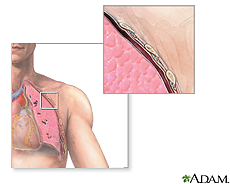

National Institutes of Health
Your pleura is a large, thin sheet of tissue that wraps around the outside of your lungs and lines the inside of your chest cavity. Between the layers of the pleura is a very thin space. Normally it's filled with a small amount of fluid. The fluid helps the two layers of the pleura glide smoothly past each other as your lungs breathe air in and out.
Disorders of the pleura include
- Pleurisy - inflammation of the pleura that causes sharp pain with breathing
- Pleural effusion - excess fluid in the pleural space
- Pneumothorax - buildup of air or gas in the pleural space
- Hemothorax - buildup of blood in the pleural space
Many different conditions can cause pleural problems. Viral infection is the most common cause of pleurisy. The most common cause of pleural effusion is congestive heart failure. Lung diseases, likeCOPD, tuberculosis, and acute lung injury, cause pneumothorax. Injury to the chest is the most common cause of hemothorax. Treatment focuses on removing fluid, air, or blood from the pleural space, relieving symptoms, and treating the underlying condition.
NIH: National Heart, Lung, and Blood Institute
- Chest CT Scan
 (National Heart, Lung, and Blood Institute)
(National Heart, Lung, and Blood Institute) - Chest MRI
 (National Heart, Lung, and Blood Institute)
(National Heart, Lung, and Blood Institute) - Chest X Ray
 (National Heart, Lung, and Blood Institute)
(National Heart, Lung, and Blood Institute) - How Are Pleurisy and Other Pleural Disorders Diagnosed?
 (National Heart, Lung, and Blood Institute)
(National Heart, Lung, and Blood Institute) - Pleural Fluid Analysis Test (American Association for Clinical Chemistry)
- Thoracentesis
 (National Heart, Lung, and Blood Institute)
(National Heart, Lung, and Blood Institute) - What Are the Signs and Symptoms of Pleurisy and Other Pleural Disorders?
 (National Heart, Lung, and Blood Institute)
(National Heart, Lung, and Blood Institute)
- Chest tube insertion - slideshow Available in Spanish
- How Are Pleurisy and Other Pleural Disorders Treated?
 (National Heart, Lung, and Blood Institute)
(National Heart, Lung, and Blood Institute)
- Cardiopulmonary Syndrome Overview
 (National Cancer Institute)Available in Spanish
(National Cancer Institute)Available in Spanish - Malignant Pleural Effusion
 (National Cancer Institute)
(National Cancer Institute) - MedlinePlus: Collapsed Lung
 (National Library of Medicine)Available in Spanish
(National Library of Medicine)Available in Spanish - Pleurisy (Mayo Foundation for Medical Education and Research)
- Pneumothorax (Mayo Foundation for Medical Education and Research)
- Genetics Home Reference: Primary spontaneous pneumothorax
 (National Library of Medicine)
(National Library of Medicine)
- ClinicalTrials.gov: Pleural Diseases
 (National Institutes of Health)
(National Institutes of Health) - ClinicalTrials.gov: Pleural Effusion
 (National Institutes of Health)
(National Institutes of Health) - ClinicalTrials.gov: Pleurisy
 (National Institutes of Health)
(National Institutes of Health) - ClinicalTrials.gov: Pneumothorax
 (National Institutes of Health)
(National Institutes of Health) - ClinicalTrials.gov: Thoracentesis
 (National Institutes of Health)
(National Institutes of Health)
- What Are the Lungs?
 (National Heart, Lung, and Blood Institute)
(National Heart, Lung, and Blood Institute)
- Chest tube insertion Available in Spanish
- Collapsed lung (pneumothorax) Available in Spanish
- Empyema Available in Spanish
- Hemothorax Available in Spanish
- Lung surgery Available in Spanish
- Lung surgery - discharge Available in Spanish
- Metastatic pleural tumor Available in Spanish
- Pleural effusion Available in Spanish
- Pleural fluid culture Available in Spanish
- Pleurisy Available in Spanish
- Pneumothorax - infants Available in Spanish
- Thoracentesis Available in Spanish
12/28/2015 12:06 PM EST
Source: National Institutes of Health
Related MedlinePlus Page: Pleural Disorders |






















.png)











No hay comentarios:
Publicar un comentario